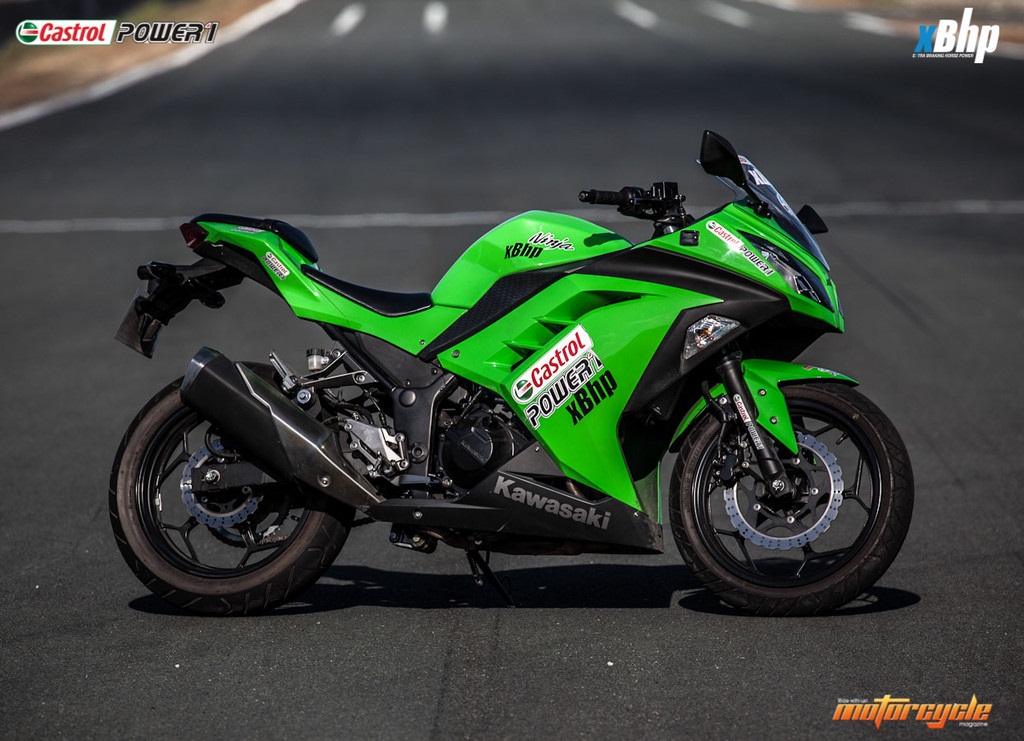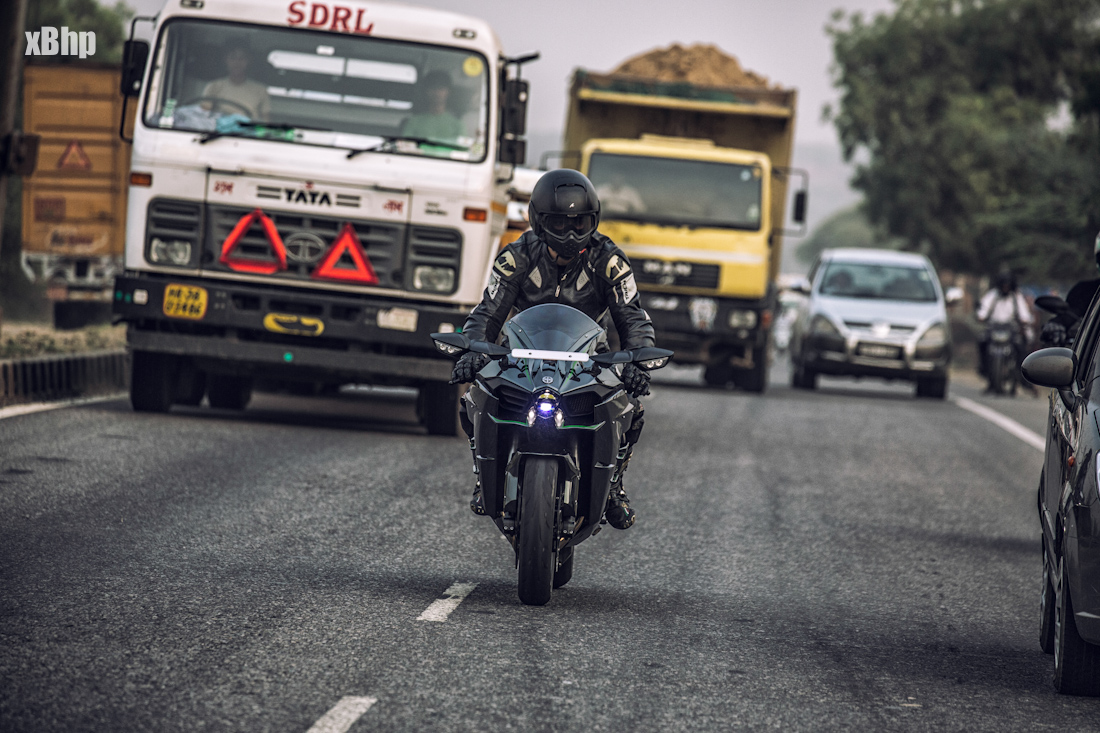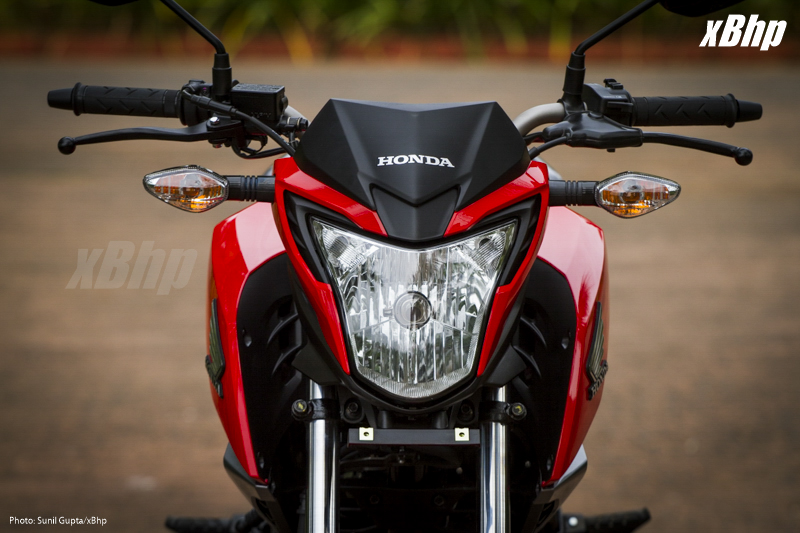The Triumph Bonneville Review by xBhp; with price, specifications and much more.
Mixing the soulful charm of a classic with the functionality of a modern machine is not an easy task, at least not as apparently simple as it appears with the Bonneville. Visually it is a peace offering – evoking warmth inside akin to that inside glow on meeting an old loved friend. It is so ‘motorcycle-like’ in elements, proportions, appeal and as a whole. You want to ride it but without rushing into it. Quite unintentionally, you slow down as you walk towards it, go around it with a light hand brushing all over and then take a short step back before finally swinging a leg over that saddle. Those proportions don’t hide the low height courtesy those 17 inch die-cast wheels. So the saddle height (740 mm or 29 inches) is accommodative for anyone standing north of 5 ft. vertical. And yet for my ‘well-fed’ 5’11” frame, the feeling of being at home on the rider’s seat was apparent. Conclusion: good static ergonomics huh!
Okay, let’s be systematic in knowing the steed first before jumping on to the nitty-gritty. The Bonnie’s design harks back to some 5 decades in the past when it was the iconic symbol of independence riding astride rebellion. It was the ride of the era and the dream of every youngster, middler and oldie in love with two wheels alike. And it comes alive again on our shores. Powered by that 865cc air-cooled (with an oil-cooler though) DOHC (double over-head cam) parallel twin with the famed 360o firing interval, this is motorcycling at the simplest and yet phenomenally effective. 68 PS at 7500 rpm and 68 NM torque at a low 5800 rpm means you have the best of both worlds wrapped and rolling under that right palm. Pull through the gears for a quick getaway or laze around town in 4th just needing a slight twist of the throttle to get past the slow-hogs. Easy riding which allows you to sit up. The engine is silky smooth and there was no hint of any fuelling glitch except just off-throttle from idle – a slight hesitation there but that could have been the dubious Gurgaon fuel quality at work. The fuel injection is well worked through – yes – those fake carburettors are fakes as carbs, but real at the throttle bodies. The rpm’s build up briskly though the engine doesn’t make much noise. That plain-Jane aural signature could be a disappointment to some, but for the likes of yours truly who staunchly believes in Theodore Roosevelt’s famous advice on speaking softly and carrying a big stick, the sound is just right!
Switch on the ignition – that is if you can find the ignition key slot on the left side headlamp bracket! Truly unique for any motorcycle I have ever ridden. Thumb the starter and the softly tuned thoroughly unstressed engine comes to life and quickly settles to a steady idle even on a chilly morning. It’s a British bike after all and so the cold is never an issue! Blip the throttle and the engine responds with alacrity. Pull in the surprisingly light clutch, shift to first and get underway. Oh! Was riding an 800+ cc bike ever so simple. Work through the gears and as long as you’re retro on the throttle, the Bonnie gives no hint of a relatively large powerplant. The traditionally shaped tank nestles between the knees, the bars provide the right leverage and yet the sheer light-footedness of the bike takes you by surprise. The staid geometry (4.5 inches of trail and 27o rake) coupled with 17 inch wheels and narrow section tyres (110 up front and a 130 at the rear) makes this bike handle like a motorcycle a third its weight and engine capacity. Flickability is crisp without an iota of loss in straight-line stability, thanks to that longish 1490 mm wheelbase coupled with a rigid frame and swing-arm. The suspension is simple, telescopic forks up front and twin shock-absorbers at the rear. The simplicity, though evocative and passably effective, is probably the only weakness in the Bonnie if you feel like exploiting that sweet engine and spot on geometry. The rear gets sprightly and the front flighty on anything but smooth tarmac while cranked over at speed. But go easy as the character of the bike demands and all is perfect.
The brakes are great. Feedback was superb and grip was amazing. You could grade the braking, especially up front, to the tiniest degree. In all probability the superb Metzelers the bike comes shod with have a substantial role to play in this as in the handling. The Bonnie is not light, tipping the scales at 225 kilos wet but on the move, all that weight does the vanishing trick pronto! The almost 2.5 ft. wide handlebars provide enough leverage to lift half a ton given the right fulcrum and so make handling the bike a breeze even while rolling it around the garage. The bars though feel a trifle close to the body and could have been less pulled back. The instrumentation is bare basic and could have been made more attractive and comprehensive but then the blending of the classic and modernity imposes its own rules on the design. The tell-tale lights for high beam, neutral, trafficators etc. are bright enough while the analogue-digital combo display (the analogue speedo is graduated in both kmph and mph) tells the usual tales about fuel level, odo readings, trip reads and rpm.
The one issue on the bike is the absolute absence of wind protection. There’s nowhere to hide and when the pace is upped to triple digits (in kmph usually), the wind blast is not just tiring but can also be destabilizing. Of course with the bike having been around so long and also so very popular, there are loads of aftermarket screens available and waiting for the buyer. Same with the fuel tank filler cap that’s devoid of a lock, a must in a country like ours not just to save the fuel from being pilfered but also the cap itself from being stolen! Speaking of fuel, the consumption is claimed at anywhere between 50-68 miles per gallon which works out to between 18-24 kmpl – not bad at all for an 865cc bike. The smallish 16 litre tank can at best take you a little north of 250 odd km before you start looking for a refill. Not bad but not very nice either for a bike that can be used for a fair bit of touring. Speaking of touring, the stock seat is comfy enough for a couple of hours or more but would leave you butt sore at the end of a long day. On the other hand, we the people of India are used to a series of long days even on the torture rack of the Duke 200 (yours truly included) and have walked away after repeated forays, without carrying away chronic piles!
The Bonnie, on the whole, is a bike you cannot dislike even though you might not outright love it or get excited about. I am though of that ‘in love with it’ category and like the bike not just for its sheer unpretentiousness but also for its true-to-form functionality. I want my rides to do what I ask than to do, respond measure for measure to my inputs and the Bonnie does that. She handles nimble but sure, runs like a Gazelle (standstill to a 100 kmph in less than 6 seconds) or hums like a bee. She feels solidly put together and purports more to being a companion than a servant. You’ll love the retro styling and the modern everything else. You might not like the mirrors, the number plate placement or the visible cables, but these are mere tiny blips on the radar of motorcycling that in general is glowing with fun. And topping it all, at a little above 6 lac INR, the Triumph Bonneville packs more bang for every buck that any other around. Let’s go get it.
Text: Sandeep Goswami (Old Fox)
Photos: Sunil Gupta (sunilg)
The post Triumph Bonneville Review appeared first on xBhp.com.

































































































































































































































































